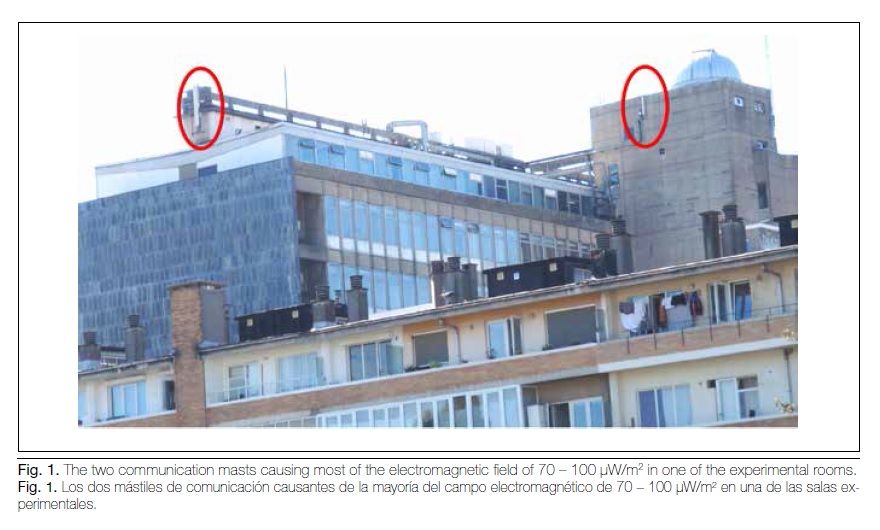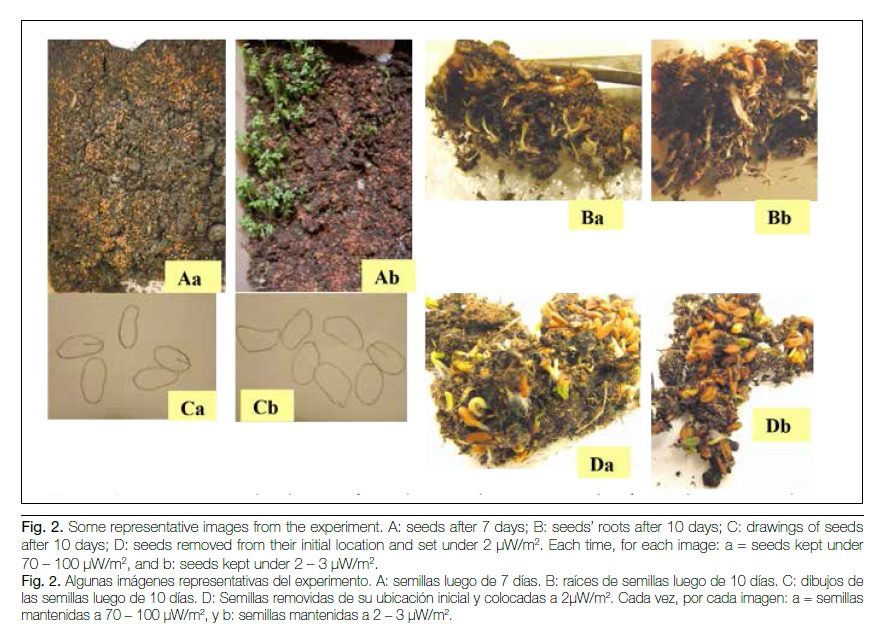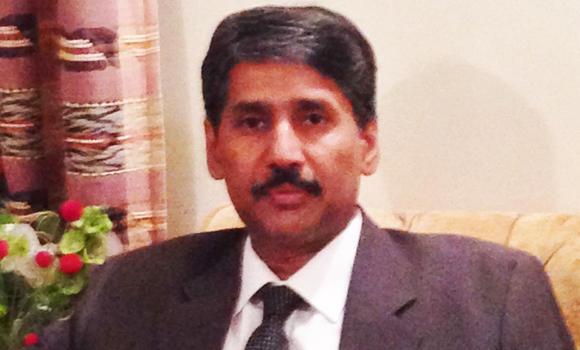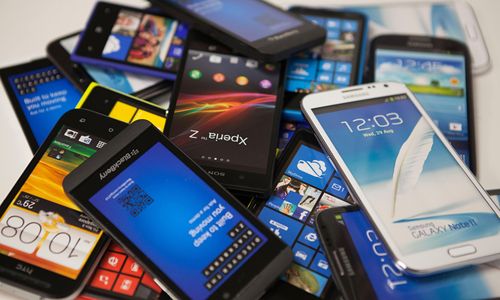[Il presente lavoro è stato condotto in conseguenza dell’esperimento svolto da un gruppo di ragazze Danesi (Lea Nielson, Mathilde Nielsen, Signe Nielsen, Sisse Coltau e Rikke Holm) alla Hjallerup Skole, sotto la supervisione del loro insegnante di biologia il sig. Kim Horsevad.
Queste ragazze hanno presentato il suddetto esperimento come parte di una fiera/concorso della scienza nazionale per gli studenti delle scuole superiori, del quale maggiori informazioni possono essere trovate al seguente sito:
www.ungeforskere.dk.
Tutto è iniziato quando le ragazze si sono accorte di avere difficoltà di concentrazione durante le lezioni e pensarono che la causa di queste (ed anche dei loro disturbi del sonno) potesse essere in relazione con il fatto di tenere il cellulare acceso di fianco al letto durante la notte.
Così hanno esposto dei semi di crescione alle emissioni elettromagnetiche tipiche dei cellulari per valutarne gli effetti biologici.
Cammaerts e Johansson hanno utilizzato i semi della Brassicacea Lepidium sativum (crescione d’Alinois), appurando che sotto gli effetti di alti livelli di radiazione (70-100 W / m2 = 175 mV / m) non sono germinati.
Infatti, il primo passo della germinazione dei semi – ad esempio le imbibizioni delle cellule germinali – non ha potuto verificarsi in presenza della radiazione, mentre all’interno del compost umido tali imbibizioni si sono verificate e le radici si sono esilmente sviluppate.
Quando rimossi dal campo elettromagnetico, i semi sono germinati normalmente.
Quindi la radiazione è stata molto probabilmente la causa del mancato verificarsi delle imbibizioni e germinazioni dei semi.
In entrambi i casi deve essersi senz’altro trattato di EFFETTO NOCEBO: d’altra parte è ben nota a tutti la incredibile suscettibilità psicologica dei semi di crescione 😉 !]
Phyton, International Journal of Experimental Botany ISSN 0031 9457 (2015) 84: 132-137
by:
Cammaerts MC (1) & O Johansson (2)
(1) Faculté des sciences, DBO, CP 160/12, Université Libre de Bruxelles, 50, Av. F. D. Roosevelt, 1050 Brussels, Belgium.
(2) The Experimental Dermatology Unit, Department of Neuroscience, Karolinska Institute, SE-171 77 Stockholm, Sweden.
Address Correspondence to: Marie-Claire Cammaerts, e-mail: mtricot@ulb.ac.be
ARTICLE INFO
Article history
Received: 27 March 2014
Accepted: 19 May 2014
Published: 2015
Keywords
Imbibitions; Seeds; Water; Wireless waves
ABSTRACT
Under high levels of radiation (70-100 µW/m2 =175 mV/m), seeds of Brassicaceae Lepidium sativum (cress d’Alinois) never germinated. In fact, the first step of seeds’ germination ‒ e.g. imbibitions of germinal cells ‒ could not occur under radiation, while inside the humid compost such imbibitions occurred and roots slightly developed. When removed from the electromagnetic field, seeds germinated normally. The radiation was, thus, most likely the cause of the non-occurrence of the seeds’ imbibitions and germination.
RESUMEN
Las semillas de Lepidium sativum, Brassicaceae, nunca germinaron bajo altos niveles de radiación (70-100 µW/m2 =175 mV/m). En realidad, el primer paso en la germinación de las semillas – ej. imbibición de las células germinales – no ocurrió bajo radiación, mientras que tal imbibición ocurrió dentro del compost húmedo y las raíces desarrollaron un poco. Cuando las semillas fueron removidas del campo magnético, las mismas desarrollaron normalmente. La radiación fue obviamente la causa que no ocurriera la imbibición y la germinación de las semillas.
INTRODUCTION
The present work was undertaken consequently to that performed by a group of Danish girls (Lea Nielson, Mathilde Nielsen, Signe Nielsen, Sisse Coltau and Rikke Holm), at Hjallerup Skole, under the supervision of their biology teacher Mr. Kim Horsevad. These girls made an experiment as a part of a national science fair/competition for high school pupils about which more information can be found at the website
www.ungeforskere.dk
All started when the girls had difficulties concentrating in their lessons. “We all thought we experienced concentration problems in school if we slept with our mobile phones at the bedside, and sometimes we also found we had difficulties sleeping”. The five girls took 400 cress seeds and randomly spread them into 12 trays. They then placed the trays in two different rooms, at the same temperature, six in each room.
They gave to the trays the same amount of water and sunlight over 12 days, but exposed six of the trays to mobile phone radiation. In other words, six trays of seeds were placed in a room with no radiation, while six were placed in another room alongside two activated routers emitted roughly the same type of radiation as a common mobile phone. The results were obvious: the cress seeds alongside the routers did not grow at all, and some even seemingly mutated or died.
The students repeated their experiment twice. The results in both were equally dramatic, and showed a dose-response effect between the two batches. The statistical significance of the biomass reduction in the students’ tests with a p-value (2-tail) of <0.000005 is thought-provoking!
Great effort was made to characterize and measure the premises’ background electromagnetic fields and the climatic conditions. No obvious confounders were then found that could give rise to – and explain – the different growth of the irradiated and the non-irradiated seeds.
It would be tempting to just discard such observations since they have not been performed under controlled conditions, thus not following all the rules of sciences. But often, observations done outside of the regular laboratory environments are the start of new discoveries. So, we decided to try to replicate the girls’ work.
Man-made electromagnetic waves have actually largely been shown to have adverse effects on living organisms. They affect, for instance, mammals (Adang et al., 2006; Benlaidi & Kharroussi, 2011), birds (Everaert & Bauwens, 2007), amphibians (Balmori, 2006), bees (Kimmel et al., 2007, Sharma & Kumar, 2010; Favre, 2011), ants (Cammaerts et al., 2012, 2013), fruit flies (Panagopoulos et al., 2004; Panagopoulos, 2012), and even protozoa (Cammaerts et al., 2011). In fact, they act firstly and essentially on the cellular membrane and so affect any living organism (Cammaerts et al., 2011). Such waves have also been shown to impact plants (Roux et al., 2008; Haggerty, 2010), at physiological and ecological levels.
In order to bring some new information on the subject, we here examine if man-made electromagnetic waves impact plants’ germination and more precisely the first events occurring at the beginning of that germination. We are conscious that our observations are only preliminary ones and that further studies (replication, cytological observations, and physiological studies) are necessary to verify the present finding and to understand what is actually and exactly occurring in germinal cells under radiation.
MATERIALS AND METHODS
Four identical series of seeds of Brassicaceae Lepidium sativum (cress d’Alinois) (same quantity, quality, origin, age) were deposited on identical compost (same initial sample), each one in an identical tray (20 cm x 15 cm x 4 cm). Compost is the commonly used material for obtaining germination of seeds. The compost was humidified with same quantity (100 ml) of the very same tap water. Two of these trays were set at a place where the electromagnetic field reached an intensity of 70 – 100 µW/m2 (= about 175 mV/m), this being mainly due to the presence of two communication masts at about 200 meters of distance (Fig. 1). The two other trays were set at another place where the electromagnetic field had an intensity of about 2 – 3 µW/m2 (= 30 mV/m). These two series of seeds, set under low radiation level, were used as the control sample.
Since the existing electromagnetic fields were generated by communication masts, the frequencies of the emitted waves were 900 MHz and/or 1,800 MHz. The intensity of the electromagnetic fields was measured using an HF 35 C radiation intensity meter for frequencies from 800 MHz to 23 GHz (Gigahertz solutions GmbH, Am Galgenberg 12, D-90579 Langenzenn, Germany). All the other environmental conditions were near-identical for each of the two double series of seeds (temperature = 20 °C, humidity = 70%, luminosity ≈ 300 lux). The seeds were then observed after four, seven and ten days, and tap water was poured on the compost, equally for each series of seeds, at regular intervals. When obvious differences were surprisingly observed between the seeds set under the two different levels of electromagnetism exposition, samples of seeds were removed, attentively observed and examined under a stereomicroscope. Seeds which had been maintained under two different levels of radiation were drawn using a camera lucida (magnification = 25x), and via these drawings, their length and their width (two orthogonal segments) were measured in mm. The means of the obtained values were established and the distributions of values (for the length on one hand, for the width on the other hand) corresponding to each two kinds of seeds were statistically compared using the nonparametric χ² tests, the level of probability being set at p<0.05 (Siegel & Castellan, 1989). After these assessments, samples of each kind of seeds were set under the lower exposure and observed once more after two days.

Germination did not occur under 70 – 100 μW/m2. After four days, the seeds set under the two different electromagnetic field strengths already differed: those under the lower level had begun to germinate while those under the higher level of electromagnetic field had not at all done so. After seven days in total, many seeds maintained under low level of exposure had completed their germination and other ones were in the process of their germination while the seeds set under the higher level of exposure appeared unchanged (when looking at them from above) (Fig. 2 A). The experiment was continued until a total of 10 days with, at that time, the same results as above: normal germination for the seeds under low radiation, apparently no germination for those set under the higher radiation.
In the humid compost, roots development occurred. Ten days after the beginning of the experiment, seeds set under the higher exposure (having not germinated) as well as seeds maintained under low exposure (being in the process of their germination) were collected, i.e. taken using small pins and put into cups. First, they were visually examined, and after that, observed under the stereomicroscope.
First, while doing this manipulation, we clearly detected some external difference between the two kinds of seeds.
Those kept under higher radiation were dry, not clinging at all while those kept without nearly no radiation were wet, clinging, and often attached to one another.
Secondly, very surprisingly, inside the humid compost, small roots of seeds set under radiation had developed, nearly like for seeds kept without radiation, with the difference that, in the latter case, the roots were somewhat more developed (Fig. 2B). It might be possible that, inside the compost and the water it contains, the electromagnetic field either had a lower intensity (through shielding effects) or had its adverse effects decreased or even countered (compared to the situation existing above the compost). Of course, if the effects we see are dependent only on the radiation, the most sensitive plant parts would be the ones above the soil, and they would be the first to be affected/retracted/not developed.
Seeds’ imbibitions did not occur under 70 – 100 μW/m2. The two kinds of seed, collected as related above, were observed under a stereomicroscope, drawn (Fig. 2 C), and measured as explained in the ‘Material and methods’ section. For seeds set under 2 – 3 µW/m2, the two variables on average equaled 0.51 mm and 0.27 mm while for seeds set under 70 – 100 µW/m2, these variables on average equaled 0.45 mm and 0.21 mm. Statistically, 0.45 mm turned out only slightly different from 0.51 mm (χ² = 3.34; df = 1; p ≈ 0.05) while 0.21 mm strongly differed from 0.27 mm (χ² = 10.77; df = 1; p ≈ 0.001). The more affected variable was thus the seeds’ width. Consequently, it could be presumed that without radiation, seeds normally went through the expected imbibitions phenomenon (the first step of the plants’ germination) while under radiation, seeds were no longer able to go through this essential first step of their germination.

According to the previous observation (see previous paragraph), it may be added that the germinal cells of the roots, located inside (surrounded by) humid compost, could realize such imbibitions.
Seeds exposed were still alive. The two kinds of collected seeds were then taken out of their initial location and set, each one, in a small tray (10 cm x 5 cm x 4 cm), the two trays then being deposited side by side, in a room where the level of radiation was low (2 µW/m2). The seeds having begun their germination went on doing so and those having not germinated began to do so, this becoming apparent after two days (Fig. 2 D).
DISCUSSION
The fact that man-made electromagnetic waves probably have adverse effects on living organisms is actually more and more realized and admitted. Reviews on the subject exist (Pakhomov & Murphy, 2000; Fragopoulou et al., 2010; Sivani & Sudarsanam, 2012; Cucurachi et al., 2013). However, first, the mechanism underlying such adverse effects are not yet fully understood so it is difficult to counteract these effects while still going on using any wireless technology. Secondly, the revealed adverse effects apparently do not worry public health authorities, parliaments, governments, and – thus – not the general public who is not fully informed. Indeed, the wireless technology is actually more and more used, both for human work tasks and hobbies. Users are not worried probably because the revealed adverse effects appear not to be emergent for human beings, i.e. effects on Protozoan’s locomotion (Cammaerts et al., 2011), on Drosophila’s reproduction (Panagopoulos, 2012, Panagopoulos et al., 2004), on ants’ memory (Cammaerts et al., 2012) and response to pheromones (Cammaerts et al., 2013), on bees’ collection of pollen (Sharma & Kumar, 2010), on amphibian’s embryogenesis (Balmori, 2006), on rat’s memory (Adang et al., 2006), and so on, although they -of course- are! Here, we reveal yet an impact of man-made electromagnetic waves on a very important phenomenon: the germination of the seeds of plants. We show that the first essential step of the germination (= the imbibitions) seemingly does not occur under radiation and that the electromagnetic waves are the only likely cause of such a non-occurrence. We presume that the cellular membrane organization, the water and ions transfer through that membrane are perturbed. Indeed, we have previously shown that the cellular membrane is strongly affected by electromagnetism (Cammaerts et al., 2011), which explains, in our mind, the impact of such electromagnetism on nervous cells, reproduction and behavior. Other data are also in favor of such an assumption (see the review of Marino and Carrubba, 2009). Let us add that seeds are often deposited onto the ground and not set inside the earth, and are so potentially maximally exposed to electromagnetism. On the other hand, such electromagnetism has been shown to impact, among others, the health of plants (Belyavskaya, 2004; Roux et al., 2008; Haggerty, 2010; and four Web sites in the list of references). Plants are truly and very necessary for life on earth; people should now be very conscious of this potentially emerging problem!
In conclusion, the present investigation -although preliminary in its character- indicates that the prodigious wireless technology may effectively and seriously impact nature and should urgently be used much more cautiously (see also the published work of Doyon (2008)). The present study also brings some new information on the subject -effect of electromagnetism on plants- but it must be replicated on several plants species, at different independent laboratories, as well as developed further at the cytological and physiological levels by botanists, histologists and physiologists. Finally, in essence, it clearly supports the initial findings of Lea Nielson, Mathilde Nielsen, Signe Nielsen, Sisse Coltau and Rikke Holm, at Hjallerup Skole, under the supervision of their biology teacher Mr. Kim Horsevad.
Conflict of Interest Statement
The authors know of no conflict of interest related to this work.
ACKNOWLEDGEMENTS
Olle Johansson was supported for this study by the Karolinska Institute, and Einar Rasmussen, Kristiansand S, Norway, Brian Stein, Melton Mowbray, Leicestereshire, UK, The Irish Campaign against Microwave Pollution, and the Irish Doctors Environmental Association (IDEA; Cumann Comhshaoil Dhoctuiri na hEireann), are gratefully acknowledged for their general support.
REFERENCES
Adang, D., B. Campo & A. Vander Vorst (2006). Has a 970 MHz Pulsed Exposure an Effect on the Memory Related Behaviour of Rats? Wireless Technology 135-138.
Balmori, A. (2006). The incidence of electromagnetic pollution on the amphibian decline: Is this an important piece of the puzzle? Toxicology and Environmental Chemistry 88: 287-299.
Belyavskaya, N.A. (2004). Biological effects due to weak magnetic field on plants. Advances in Space Research 34: 1566-1574.
Benlaidi, F.Z. & M. El Kharroussi (2011). Effets des ondes électromagnétiques générées par le GSM sur la mémoire et le comportement chez le rat. http://sites.google.com/site/9drineuro/r%C3%A9sum%C3%A9s6.
Cammaerts, M.-C., O. Debeir & R. Cammaerts (2011). Changes in Paramecium caudatum (Protozoa) near a switched-on GSM telephone.
Electromagnetic Biology and Medicine 30: 57-66.
Cammaerts, M.-C., P. De Doncker, X. Patris, F. Bellens, Z. Rachidi & D. Cammaerts (2012). GSM 900 MHz radiations inhibits ants’ association between food sites and encountered cues. Electromagnetic Biology and Medicine 31: 151-165. DOI: 10.3109/15368378.2011.624661.
Cammaerts, M.-C., Z. Rachidi, F. Bellens & P. De Doncker (2013).
Food collection and responses to pheromones in an ant species exposed to electromagnetic radiation. Electromagnetic Biology and Medicine 1-18,Q Informa UK Ltd ISSN 1536-8378 print/ISSN 1536-8386 online DOI: 10.3109/15368378.2012.712877.
Cucurachi, S., W.L. Tamis, M.G. Vijver et al. (2013). A review of the ecological effects of radiofrequency electromagnetic fields (RF-EMF). Environnement International Journal 51: 116-140. http://www.sciencedirect.com/science/article/pii/ S0160412012002334.
Doyon, P.R. (2008). Are the microwaves killing the insects, frogs, and birds? And are we next? http://www.thenhf.com/article. php?id5480.
Everaert, J. & D. Bauwens (2007). A possible effect of electromagnetic radiation from mobile phone base stations on the number of breeding house sparrows (Passer domesticus). Electromagnetic Biology and Medicine 26: 63-72.
Favre, D. (2011). Mobile phone-induced honeybee worker piping.
Apidologie, Springlink.com DOI: 10.1007/s13592-011-0016-x.
Fragopoulou, A., Y. Grigoriev, O. Johansson et al. (2010). Scientific panel on electromagnetic field health risks: Consensus points, recommendations, and rationales. Scientific Meeting: Seletun,
Norway, November 17-21, 2009. Review of Environment and Health 25: 307-317.
Haggerty, K. (2010). Adverse Influence of Radio Frequency Background on Trembling Aspen Seedlings: Preliminary Observations. International Journal of Forestry Research, DOI: 10.1155/2010/836278. article ID 836278, 7 p.
Kimmel, S., J. Kuhn, W. Harst et al. (2007). Electromagnetic Radiation:
Influences on Honeybees (Apis mellifera). www.hese-project.org/hese-uk/en/papers/kimmel_iaas_pdf
Marino, A.A. & A. Carrubba (2009). The effects of mobile phone electromagnetic fields on brain electrical activity: A critical review
of literature. Electromagnetic Biology and Medicine 28: 250-274. http://andrewamarino.com/PDFs/CellphoneEMFs-Review.pdf.
Pakhomov, A.G. & M.B. Murphy (2000). Comprehensive review of the research on biological effects of pulsed radiofrequency. Advances in Electromagnetic Fields in Living System 3: 265-290. http://www.mtt-serbia.org.rs/microwave_review/pdf/Vol11No2-03-IBelyaev.pdf
Panagopoulos, D.J. (2012). Gametogenesis, embryonic and postembryonic development of Drosophila melanogaster, as a model system for the assessment of radiation and environmental genotoxicity. Drosophila melanogaster, lifecycle, genetics… Ed M. Spindler-Barth, Nova Science Publishers, Inc, 1-38.
Panagopoulos, D.J., A. Karabarbounis & L.H. Margaritis (2004). Effect of GSM 900-MHz mobile phone radiation on the reproductive capacity of Drosophila melanogaster. Electromagnetic Biology and Medicine 23: 29-43.
Roux, D., A. Vian., S. Girard, P. Bonnet, F. Paladian, E. Davies & G. Ledoigt (2008). High frequency (900 MHz) low amplitude (5 V/m) electromagnetic field: a genuine environmental stimulus that affects transcription, translation, calcium and energy charge in tomato. Planta 227: 883-891.
Sharma, V.P. & N.R. Kumar (2010). Changes in honeybee behavior and biology under the influence of cellphone radiations. Current Science 98: 1376-1378.
Siegel, S. & N.J. Castellan (1989). Nonparametric statistics for the behavioural sciences. – McGraw-Hill Book Company, Singapore, 396 p.
Sivani, S. & D. Sudarsanam (2012). Impacts of radio-frequency electromagnetic field (RF-EMF) from cell phone towers and wireless
devices on biosystem and ecosystem – a review. Biology and Medicine 4: 202-21.
http://www.wageningenuniversity.nl/NL/nieuwsagenda/nieuws/Bomen101120.htm
http://www.dailymail.co.uk/sciencetech/article-1332310/Is-Wi-Fikilling-trees-Dutch-study-shows-leaves-dying-exposure-Wi-Fi-radiation.html
http://readwriteweb.com/cloud/2010/11/study-wi-fi-is-makingour-tree.php
http://www.greenpeace.org/canada/fr/Blog/le-wi-fi-tuerait-les-arbres/blog/33569/
Source/Fonte:
http://www.mast-victims.org/resources/docs/Cammaerts-Johansson-watercress-replication-2015.pdf







